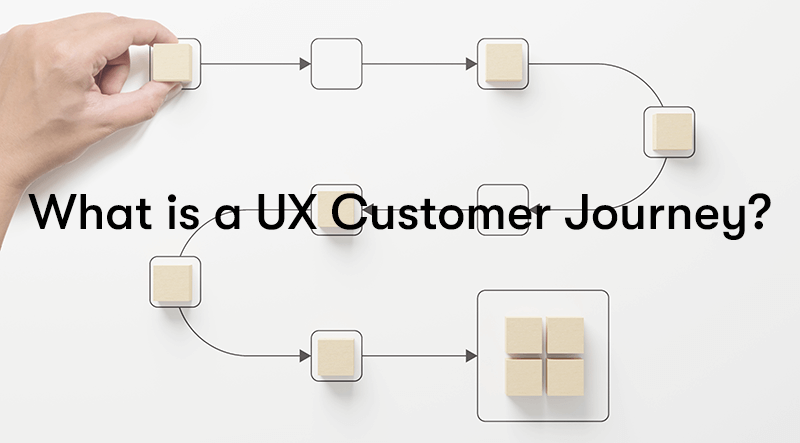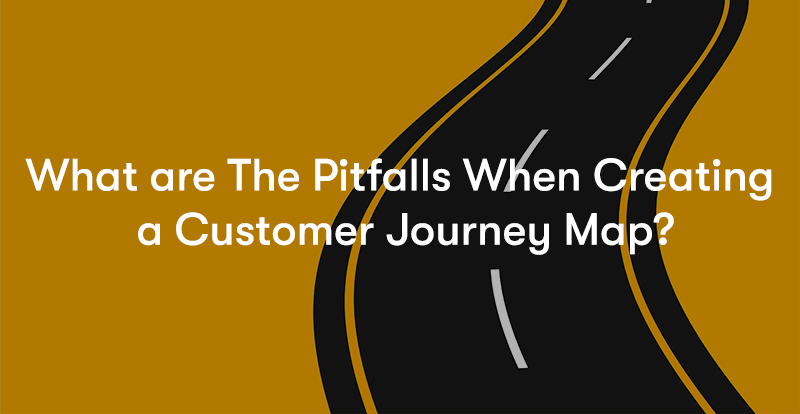UX Customer Journey
Welcome to our blog on UX (User Experience) Customer Journey, a crucial aspect of modern business strategy. We will delve deep into the art and science of mapping the intricate pathways customers traverse when interacting with your products, services, or brand. By dissecting this journey's stages, emotions, and touchpoints, we unlock profound insights into user behaviour, desires, and pain points.
We aim to optimise the user experience and uncover the advantages, potential pitfalls, and step-by-step methods for creating effective customer journey maps. Join us on this journey to empower your organisation with the tools to deliver user-centric excellence.
What is a UX Customer Journey?

A UX customer journey is a visual representation of a customer's steps when interacting with a product, service, or brand. It is a valuable tool used in user experience design and customer experience management to understand and improve a customer's overall experience throughout their interaction with a company.
What are The Advantages of Creating a UX Customer Journey Map?
Creating a UX customer journey map offers several advantages for businesses and organisations:
Deep Understanding of Users
Customer journey maps provide insights into the entire user experience, helping businesses better understand their customers' needs, behaviours, and pain points.
Empathy Building
Mapping out the user journey helps teams empathise with their customers by visualising their experiences, emotions, and frustrations, which can lead to more user-centred design and decision-making.
Improved User-Centric Design
By identifying pain points and areas of opportunity, businesses can design products, services, and interfaces that better align with user preferences and expectations.
Enhanced Product Development
Customer journey maps can inform product development by highlighting key touchpoints where new features or improvements can be implemented to enhance the overall user experience.
Better Communication
They provide a common language and visual representation that facilitates communication and collaboration among cross-functional teams, such as marketing, design, development, and customer support.
Identifying Opportunities for Innovation
Customer journey maps can reveal unmet user needs or areas where innovation can differentiate a product or service in the market.
Reduced Churn
Addressing pain points and improving the overall user experience can lead to increased customer satisfaction, loyalty, and reduced churn rates.
Strategic Decision-Making
Journey maps help inform strategic decisions related to marketing, sales, customer support, and product roadmaps, ensuring that efforts are focused on areas that matter most to users.
Optimised Marketing Campaigns
Marketers can use customer journey maps to tailor their campaigns to specific journey stages, delivering more relevant and personalised messages to users.
Resource Allocation
Organisations can allocate resources more efficiently by prioritising initiatives based on the most critical touchpoints and stages of the customer journey.
Continuous Improvement
Customer journey maps are not static; they evolve as user behaviours and preferences change. This encourages a culture of continuous improvement and adaptation.
Competitive Advantage
Understanding the user journey can help businesses differentiate themselves from competitors by offering a superior and more user-friendly experience.
Alignment with Business Goals
Customer journey mapping ensures that user experience improvements are aligned with overarching business objectives, ultimately contributing to the bottom line.
Customer-Centric Culture
Over time, customer journey mapping can foster a customer-centric culture within the organisation, where every decision is made with the user in mind.
Measurable Results
Improvements driven by insights from customer journey maps can be tracked and measured, allowing organisations to quantify the impact on key performance indicators (KPIs).
Creating a UX customer journey map is a valuable tool that helps businesses better understand their customers, optimise user experiences, make informed decisions, and ultimately achieve their business goals. It fosters a user-centred approach that can lead to improved products, increased customer satisfaction, and a competitive edge in the market.
What are The Pitfalls When Creating a Customer Journey Map?

Creating a customer journey map can be a valuable exercise. Still, there are several pitfalls and challenges that organisations should be aware of to ensure the map is accurate, useful, and practical. Here are some common pitfalls to avoid:
Assuming a Linear Journey
One of the biggest mistakes is assuming the customer journey is strictly linear. In reality, customers may jump back and forth between stages or skip stages altogether. Avoid oversimplifying the journey.
Lack of User Research
Relying solely on internal assumptions without conducting user research can lead to inaccurate journey maps. Gathering real user insights through interviews, surveys, or observation is crucial.
Not Considering Different Personas
Customers with different needs and characteristics may follow different paths through the journey. Failing to account for various customer personas can result in an incomplete and inaccurate map.
Overcomplicating the Map
While capturing important details is essential, overly complex journey maps can be overwhelming and challenging to use. Keep the map clear and focused on the most critical aspects.
Neglecting Emotional Factors
Customer emotions play a significant role in the journey. Failing to account for emotional ups and downs can lead to an incomplete understanding of the user experience.
Ignoring Negative Feedback
Some organisations may hesitate to include negative feedback or experiences in the journey map. However, addressing pain points is crucial for improvement.
Focusing Solely on Touchpoints
While touchpoints are essential, they represent only one dimension of the journey. Be aware of other aspects, such as customer motivations, goals, and contextual factors.
Not Involving Cross-Functional Teams
Journey mapping should involve input from various departments, as different teams have unique insights into the customer experience. Collaboration is key.
Creating a Static Document
Journey maps should evolve over time as user behaviours and preferences change. Failing to update the map can result in outdated and less relevant information.
Lack of Actionable Insights
The primary goal of a customer journey map is to drive improvements. If the map doesn't lead to actionable insights and changes in the user experience, it loses its value.
Focusing Only on Digital Touchpoints
In today's omnichannel world, the customer journey often spans digital and physical touchpoints. Ensure your map considers all relevant channels and interactions.
Not Validating with Users
Once the journey map is created, it's essential to validate it with actual users to ensure its accuracy and relevance to their experiences.
Viewing It as a One-Time Activity
Customer journeys are dynamic and evolve with changing user behaviours and market trends. Continuously update and refine your journey maps to stay relevant.
Losing Sight of Business Goals
While focusing on the user is essential, don't lose sight of your business goals. The customer journey should align with and contribute to those objectives.
Failing to Prioritise Issues
Not all pain points or opportunities identified in the journey map will be equally significant. Prioritise areas for improvement based on their potential impact on user satisfaction and business outcomes.
By being mindful of these pitfalls and addressing them during the customer journey mapping process, organisations can create more accurate, actionable, and practical maps that enhance the user experience and drive business success.
How to Create a Customer Journey Map

Creating a customer journey map involves several steps to gain insights into and improve user experience. Here's a step-by-step guide to help you create an effective customer journey map:
1. Define Your Objectives:
Clearly state the goals and objectives you want to achieve with the customer journey map. What specific insights are you seeking? What problems are you trying to solve?
2. Identify Your Customer Personas:
Determine the different types of customers or personas who interact with your product or service. Each persona may have unique needs, behaviours, and touchpoints.
3. Gather User Research:
Conduct user research to collect data and insights about your customers' experiences. This can include surveys, interviews, usability testing, analytics data, and customer feedback.
4. Define Customer Stages:
Outline the stages or phases that customers typically go through when interacting with your product or service. Common stages include awareness, consideration, purchase, onboarding, engagement, and retention.
5. List Customer Actions:
Within each stage, identify the specific actions or tasks that customers perform. What are they trying to achieve at each stage?
6. Understand Customer Emotions:
Determine customers' emotions and attitudes at different points in their journey. This helps you understand their motivations and pain points.
7. Map Touchpoints:
Identify the various touchpoints or channels where customers interact with your business. These include websites, mobile apps, social media, customer support, and more.
8. Create the Journey Map:
Visualise the customer journey by creating a diagram or infographic. You can use software tools, whiteboards, or paper. Here's how to structure the map:
- Along the horizontal axis, plot the customer stages.
- Along the vertical axis, list the touchpoints.
- Add customer actions, emotions, and relevant data at each intersection of stage and touchpoint.
9. Highlight Pain Points and Opportunities:
Identify pain points and moments of frustration in the customer journey. Also, highlight opportunities for improvement and innovation.
10. Validate with Stakeholders:
Share the customer journey map with relevant teams and stakeholders, such as marketing, product development, and customer support. Gather their input and insights.
11. Validate with Users:
Test the customer journey map with actual users to ensure it accurately represents their experiences and emotions. This step can uncover any discrepancies between user expectations and reality.
12. Prioritise Actionable Insights:
Based on the pain points and opportunities identified, prioritise actions and improvements that can significantly impact the user experience.
13. Implement Changes:
Collaborate with relevant teams to implement the recommended changes and improvements. This may involve adjustments to product features, communication strategies, or customer support processes.
14. Monitor and Update:
Continuously monitor the customer journey and collect feedback to assess the impact of changes. Update the journey map as needed to reflect evolving user behaviours and needs.
15. Share and Communicate:
Share the customer journey map and its findings with the organisation to ensure everyone understands and aligns with the user-centric approach.
Remember that creating a customer journey map is an ongoing process. As user behaviours and preferences change, you should regularly revisit and update your map to ensure it remains a valuable tool for improving the user experience and achieving your business goals.
Where can you learn more About UX?
Our BCS Foundation Certificate In User Experience training course is perfect for anyone who wants to increase their knowledge of User Experience. The BCS User Experience course will teach you the UX methodology, best practices, techniques, and a strategy for creating a successful user experience. The course will cover the following topics:
- Guiding Principles
- User Research
- Illustrating The Context Of Use
- Measuring Usability
- Information Architecture
- Interaction Design
- Visual Design
- User Interface Prototyping
- Usability Evaluation
Click the button below to find out more.

Final Notes of UX Customer Journey
In conclusion, crafting a UX customer journey map is pivotal for businesses striving to enhance user experiences. It enables a profound understanding of customer needs, emotions, and pain points throughout their interactions. However, pitfalls such as oversimplification or neglecting user research must be navigated with care.
By following a systematic approach, involving cross-functional teams, and prioritising actionable insights, organisations can create maps that empower better decision-making and foster a culture of continuous improvement. With the user at the forefront, businesses can achieve a competitive edge and sustained success in today's dynamic market.



